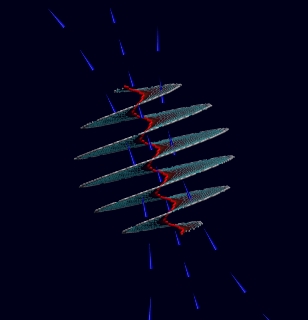Oct 20 2015
Researchers at Rice University have discovered that spiral graphene nano-coils had the capacity to produce powerful magnetic fields, and could be used as nano-sized solenoids.
 A nano-coil made of graphene could be an effective solenoid inductor for electronic applications, according to researchers at Rice University. (Credit: Yakobson Research Group/Rice University)
A nano-coil made of graphene could be an effective solenoid inductor for electronic applications, according to researchers at Rice University. (Credit: Yakobson Research Group/Rice University)
Significant advances have been made in miniaturizing electronic components. However, in comparison, solenoids are still too big. Rice University researchers have found out a way to produce nano-scale solenoids that demonstrate performance on the macro-scale.
The key to scaling down the size of the solenoids was atom-thin graphene in a spiral form that is naturally available.
“Usually, we determine the characteristics for materials we think might be possible to make, but this time we’re looking at a configuration that already exists,” Rice theoretical physicist Boris Yakobson said. “These spirals, or screw dislocations, form naturally in graphite during its growth, even in common coal.”
Yakobson is the Karl F. Hasselmann Professor of Materials Science and NanoEngineering and a professor of chemistry at Rice University.
In the same manner as it occurs in macro inductor-solenoids, current would flow when a voltage is applied. This current flow would lead to production of a magnetic field when it flows around a helical path.
“One can compare the structure to a high-rise parking lot for electrons — but without parking spaces, so the electrons just drive through,” Yakobson said. “Or you can say it resembles Archimedes’ screw — which rotates in order to pump water uphill — but filled with electricity instead.
“Perhaps this might work in reverse here: An electron current, pumped through by the applied voltage, at certain conditions may just cause the graphene spiral to spin, like a fast little electro-turbine,” he said.
Solenoids are a type of electromagnet that is made up of wires that are coiled around a metallic core. When they carry current, a magnetic field is produced that converts them into electromagnets. Solenoids are commonly used in many applications, including cars, transformers, circuit boards, and other mechanical and electronic devices. The smallest forms of solenoids are used in integrated circuits, and they are also used as inductors in electric circuits.
Fangbo Xu, a Rice alumnus and lead author of the paper, states that transistors have continued to become smaller; however, in comparison, basic inductors have become bulkier. “It’s the same inside the circuits,” he said. “Commercial spiral inductors on silicon occupy excessive area. If realized, graphene nano-solenoids could change that.”
Yakobson and his research team state that analysis of the computer models of the nano-solenoids has demonstrated that these solenoids should be able to produce powerful 1T magnetic fields. Such powerful magnetic fields exist in commonly used loudspeakers. The team found that the magnetic field was the strongest at the spiral’s center, in the nanoscale hollow cavity.
Yakobson commented that the spiral form was due to a simple topological trick. Basically, graphene is composed of hexagonal carbon atom arrays. Dislocations or malformed hexagons along one edge of the graphene material force it to twist around itself. This can be considered to be as similar to a continuous nanoribbon that imitates a Riemann surface, which is a mathematical construct.
The manner in which energy would move through the hexagons in the nano-solenoids was theoretically demonstrated by the researchers. The edges in this case had zigzag or armchair formations. The team observed that a 70nm wide nano-solenoid could match the performance of a typical 205μm diameter spiral inductor. When compared in size, the nano-solenoid was smaller by approximately 10,000,000 times.
Graphene does not have any energy band gap, and hence, this should allow electricity to flow through without any obstruction. However, the spiral width and edge configuration, which could be in a zigzag or armchair manner, influences the manner of current distribution and its inductive properties.
Furthermore, the researchers believe that the graphene screw dislocations could be isolated from the graphitic carbon crystals. However, inducing the graphene sheets to grow in a spiral manner would help control its properties in a better manner.
Xu states that nano-solenoids could possibly be used as radicals in chemical probes, switchable traps for magnetic molecules, or as molecular relays.
The study paper has been published in Nano Letters, an American Chemical Society journal.
Rice graduate student Henry Yu and alumnus Arta Sadrzadeh are the co-authors of the study.
The Office of Naval Research’s Multidisciplinary University Research Initiative, the Air Force Office of Scientific Research, and the National Science Foundation supported the study.